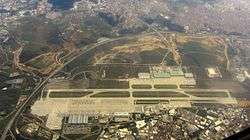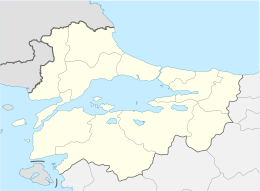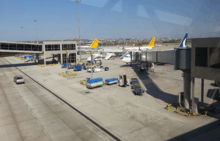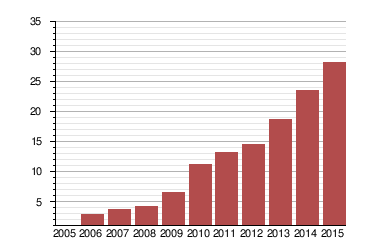Sabiha Gökçen International Airport
| Istanbul Sabiha Gökçen International Airport İstanbul Sabiha Gökçen Uluslararası Havalimanı | |||||||||||
|---|---|---|---|---|---|---|---|---|---|---|---|
|
| |||||||||||
 | |||||||||||
| IATA: SAW – ICAO: LTFJ | |||||||||||
| Summary | |||||||||||
| Airport type | Public | ||||||||||
| Owner | HEAŞ (Airport Management & Aeronautical Industries Inc) | ||||||||||
| Operator | Malaysia Airports | ||||||||||
| Serves | Istanbul, Turkey | ||||||||||
| Location | Pendik | ||||||||||
| Hub for | |||||||||||
| Time zone | EET (UTC+2) | ||||||||||
| • Summer (DST) | EEST (UTC+3) | ||||||||||
| Elevation AMSL | 312 ft / 95 m | ||||||||||
| Coordinates | 40°53′54″N 29°18′33″E / 40.89833°N 29.30917°ECoordinates: 40°53′54″N 29°18′33″E / 40.89833°N 29.30917°E | ||||||||||
| Website | sabihagokcen.aero | ||||||||||
| Map | |||||||||||
 SAW Location of airport in Northwest Turkey | |||||||||||
| Runways | |||||||||||
| |||||||||||
| Statistics (2015) | |||||||||||
| |||||||||||
Sabiha Gökçen International Airport (IATA: SAW, ICAO: LTFJ) is one of the two international airports serving İstanbul, the largest city in Turkey, the other being Atatürk Airport. Located 35 km (22 mi) southeast[1] of central İstanbul, Sabiha Gökçen is on the Asian side of the bi-continental city and serves as the hub for Pegasus Airlines as well as a base for Turkish Airlines and Borajet. The facility is named after Sabiha Gökçen, the first female combat pilot in Turkey.
Overview
The airport was built because Atatürk International Airport (located on the European side) was not large enough to meet the booming passenger demands (both domestic and international). In June 2007, Turkish conglomerate Limak Holding, India's GMR Group and Malaysia Airport Holding Berhad (MAHB) consortium gained the contract for upgrading and maintaining the airport. In mid-2008, ground was broken to upgrade the international terminal to handle 25 million passengers annually. The new terminal was inaugurated on 31 October 2009.
SAW's international terminal capacity originally was 3 million passengers per year and the domestic terminal capacity was 0.5 million passengers per year. In 2010, Sabiha Gökçen airport handled 11,129,472 passengers, a 71% increase compared to 2009.[3] The airport was planning (in 2011) to host 25 million passengers by 2023,[4][5] but handled more than 28 million passengers in 2015 already.
In September 2010, the airport was voted the World's Best Airport at the World Low Cost Airlines Congress in London and received the award.[6] The other awards received by the airport in 2010 were: Turkey’s Most Successful Tourism Investment 2010, the highly commended award from Routes Europe and the airport is honored with Airport Traffic Growth Award by Airline News & Network Analysis web site anna.aero.[7]
With 28,285,578 passengers and 206,180 aircraft movements in 2015, Sabiha Gökçen International Airport is the second busiest single-runway airport in the world (London Gatwick has two runways but only can work as a single-runway airport).[8]
Terminals
The new terminal building of 25 million annual passenger capacity conducts domestic and international flights under one roof.
The features of and the services at the new terminal of the Istanbul Sabiha Gokcen International Airport and its outlying buildings include:
- a four-storey car park with a capacity of about 4,718 vehicles + 72 bus (3.836 indoors and 882 + 72 bus outdoors).
- a four-storey hotel with 128 rooms, adjacent to the terminal and with separate entrances at air and ground sides.
- 112 check-in, 24 online check-in counters
- a VIP building & apron viewing CIP halls with business lounges
- Multi Aircraft Ramp System (MARS), allowing simultaneous service to 8 aircraft with large fuselages (IATA code E) or 16 middle-sized fuselage aircraft (IATA code C).
- a 400 m² conference center
- 5,000 m² food court, for cafés and restaurants belonging the leading food & beverage brands
- a duty-free shopping area, with a ground of 4,500 square-meters; with shops at international standards.
The airport's cargo terminal has a capacity of 90,000 tons per year and is equipped with 18 cold storage depots.
Airlines and destinations
Passenger
The following airlines operate regular scheduled and charter flights to and from Sabiha Gökçen International Airport:[9]
Cargo
Statistics
Traffic figures

| Year | Domestic | % change | International | % change | Total | % change |
|---|---|---|---|---|---|---|
| 2016 (Oct.) | 17,014,543 | 8,066,840 | 25,081,383 | |||
| 2015 | 18,535,463 | 9,576,975 | 28,112,438 | |||
| 2014 | 15,008,600 | 8,499,541 | 23,508,141 | |||
| 2013 | 11,947,424 | 6,694,418 | 18,641,842 | |||
| 2012 | 9,486,469 | 5,000,773 | 14,487,242 | |||
| 2011 | 8,704,249 | 4,420,421 | 13,124,670 | |||
| 2010 | 7,435,158 | 3,694,314 | 11,129,472 | |||
| 2009 | 4,547,673 | 2,092,285 | 6,639,958 | |||
| 2008 | 2,764,856 | 1,516,337 | 4,281,193 | |||
| 2007 | 2,528,549 | 1,191,946 | 3,720,495 | |||
| 2006 | 2,153,561 | 762,893 | 2,916,454 | |||
| 2005 | 559,824 | 459,922 | 1,019,746 | |||
| 2004 | 10,323 | 235,278 | 245,601 | |||
| 2003 | 2,826 | – | 154,346 | – | 157,172 | – |
Passenger development
 |
Ground transport
Sabiha Gökçen International Airport is connected to the city of Istanbul and that city's wider metropolitan area through a number of transport corridors.
Rail
The airport is located 14 km from the town of Pendik's railway and sea-taxi stations but a connection via Marmaray is planned.
Metro
The M4 metro line is being extended towards the airport. The current terminus at Kartal can be reached by a long bus or taxi ride.
Shuttlebuses and coaches
Shuttlebuses serve Taksim and Kadikoy and there are coaches to nearby towns and cities.
Car and taxi
The main airport complex is reachable by car from the E80 (Trans-European Motorway) which passes through the Istanbul Metropolitan Area.
Accidents and incidents
- On 23 December 2015 at approximately 2:00 AM, explosions were reported to have occurred in a parked Pegasus Airlines aircraft, killing one cleaner and wounding another inside the plane. Five nearby planes were reported to be damaged as well. The operations were reported to continue normally soon after, however with heightened security measured in place.[11] Three days later, it was reported that "PKK-affiliated terrorist group". Kurdistan Freedom Falcons had organized the attack.[12]
References
- 1 2 EAD Basic. Ead.eurocontrol.int. Retrieved on 2011-08-01.
- ↑ "ACI EUROPE Airport Traffic Report. December, Q4 and Full Year 2015" (PDF). Retrieved 28 August 2016.
- ↑ 2010 airport statistics. Retrieved on 2011-08-01.
- ↑ İstanbul's 2nd Airport To Reach 25 Million Passengers By 2023. Nasdaq.com (2011-05-24). Retrieved on 2011-08-01.
- ↑ Sabiha Gökçen'de rekor yolcu sayısı. Hurriyet.com.tr. Retrieved on 2011-08-01.
- ↑ Sabiha Gökçen dünyanın en iyi havalimanı seçildi – Hürriyet Ekonomi. Hurriyet.com.tr. Retrieved on 2011-08-01.
- ↑ "EURO ANNIES 2011: Airport Awards". anna.aero Airline Network News & Analysis. Retrieved 19 May 2011. In December 2013, MAHB acquired GMR's 40 percent stake in a deal worthed 225 million euros.
- ↑ World`s busiest single-runway commercial airports. Retrieved on 2016-11-13.
- ↑ sabihagokcen.aero - Flight Destinations retrieved 3 August 2016
- ↑ DHMİ Genel Müdürlüğü. "Devlet Hava Meydanları İşletmesi Genel Müdürlüğü". dhmi.gov.tr. Retrieved 1 June 2015.
- ↑ Daren Butler (23 December 2015). "Suspected bomb kills one at Istanbul airport, investigation launched". Reuters UK.
- ↑ "PKK-affiliated terrorist group claims responsibility for Istanbul airport attack". DailySabah. 26 December 2015.
External links
![]() Media related to Sabiha Gökçen International Airport at Wikimedia Commons
Media related to Sabiha Gökçen International Airport at Wikimedia Commons
- Official website
- Current weather for LTFJ at NOAA/NWS
- Accident history for SAW at Aviation Safety Network